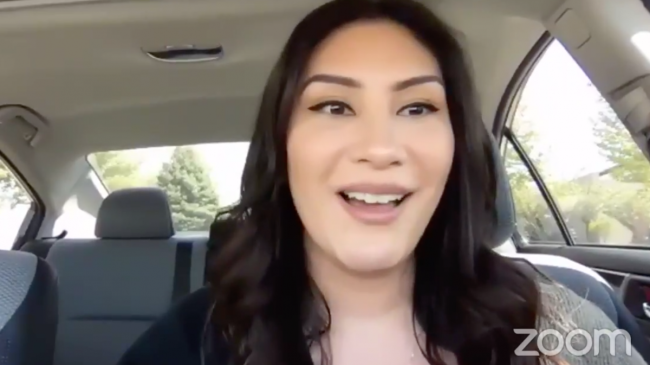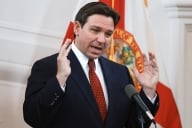You have /5 articles left.
Sign up for a free account or log in.

Savanna Navarro Kresse studies from a Washington State University parking lot several hours per week due to Wi-Fi issues at home.
Facebook Live
Savanna Navarro Kresse, a senior history major at Washington State University, Tri-Cities, participated in a local Facebook Live broadcast this week about higher education during COVID-19. Her smart answers and calm demeanor masked her discomfort: she was answering questions from her car, parked in a campus lot, with the sun overhead. She badly wanted to turn on her air-conditioning, but she needed to keep ambient noise to a minimum.
Kresse dealt with the conditions, as she does often. Since COVID-19 hit, she’s spent two or three hours per week in the same parking lot, doing classwork or taking tests online. Studying in her car is hardly ideal, but this is the only place she can access reliable Wi-Fi.
“It can be a little weird taking a test in your car,” she said. “Looking at your books or notes while holding your laptop on your lap can be awkward, too. It can be worse when your tests have a time limit and you’re trying to hurry and look through notes.”
Academe has more than risen to the challenges posed by the rapid transition to remote instruction. But the entire shift was predicated on the notion that all students have access not only to a computer, but to reliable internet access. In reality, many do not.
While some students report finishing up the semester with only their phones, many institutions have done their best to loan laptops to computerless students who would otherwise be working in on-campus computer labs. The internet access problem is more complicated, however.
Some students, especially in rural areas, have no broadband internet availability. Others have generally spotty Wi-Fi or experience router overload when multiple devices are working at once within a home. Data plans get maxed out, too.
That’s just connectivity. The other issue is affordability, or whether or not students can pay for internet access where it's available. Many can’t.
All these concerns existed prior to COVID-19. But the pandemic has exposed them and exacerbated them in ways that may only widen documented achievement gaps.
Karen Stout, president of Achieving the Dream, a nonprofit working to ensure community college student success, said that these inequities are why community colleges were some of the last institutions to move to all-remote instruction.
“We knew we were putting some students at risk,” she said. “We know that many community colleges students use our libraries to do their distance learning courses, for instance, taking courses online but using our libraries to do so.”
Stout said that the need is most acute among students at rural and tribal colleges.
When going remote became inevitable, the “first wave” of response was to get devices into students’ hands, she said. The next wave was about internet access, including “this very organized movement to make community college parking lots into Wi-Fi hotspots.”
Signal Boost
Some colleges already offered Wi-Fi in their parking lots. Others installed signal boosters to extend their Wi-Fi to specific lots for the pandemic. Some have announced hours of lot operation, mainly to offer security, along with rules for social distancing: one space between each car, for example.
While various institutions require student credentials to log in to the Wi-Fi, others have invited the greater community -- including K-12 students -- to share access.
Achieving the Dream is currently studying the ways colleges have responded to student needs during the pandemic and to what degree students have engaged with services offered. Stout called it the “COVID Dashboard."
She applauded colleges for their “creativity” thus far in supporting students and noted that some have made Wi-Fi-ready parking lots access points to campus food pantries.
At the start of the pandemic, Tri Cities reached out to students about their Wi-Fi needs. Kresse thought she was covered, as she had Wi-Fi at home. Since then, however, the connection has failed to support her schoolwork and that of her four children (she calls herself a post-traditional student). She bought a new router as soon as she received payment from federal economic stimulus funds, but it did little good.
To limit her need for Wi-Fi, she generally reads transcripts and studies PowerPoints from her synchronous class meetings instead of tuning in live. But there are times -- including when she's taking tests -- that she needs a strong signal. And for that she heads to her campus lot.
Kresse said it would help students like her if they could log in and out of tests multiple times, to accommodate for Wi-Fi challenges, concerns about academic integrity notwithstanding. Wi-Fi hotspots devices and clear guidelines for who qualifies for them would also be helpful, she said. (Washington State is in the process of providing more of these.)
“It would also be nice if the state or the federal government stepped in,” Kresse said. “What this is showing us is an infrastructure problem.”
Charles M. Roessel, president of Diné College in the Navajo Nation, said students have used “parking lots, tops of hills and mesas and anywhere else where the signal is strong enough to access our online classes.”
The college purchased laptops and wireless hotspots for students and faculty members, but professors have still had to be “flexible, with some of them providing four different delivery methods for one class each and every week (Zoom, text, email and telephone),” Roessel added via email. Many students drive 30 to 50 miles to get a faint signal, and while their dedication is inspiring, “a student should not expend all of their creativity just to connect to the internet.”
Diné has received temporary federal approval to access an unused 2.5 GHZ spectrum, which will allow students to have full and free access internet access, Roessel said. “We are opening this up to all college students and not just Diné.”
Marta Yera Cronin, president of Columbia Gorge Community College in Oregon, said that the pandemic has shown, among other things, that “technology is not the great equalizer that some people think it is,” even in the U.S. in 2020.
Columbia Gorge's Wi-Fi is always accessible in its parking lots. (Computer labs also stayed open for a time after the instruction went remote, but the college observed that students were afraid to use them, despite strict hygiene and social distancing requirements.) The institution also checked out dozens of hotspot devices to students so that they wouldn’t have to visit campus. Some live as far as 90 minutes away.
Cronin's college recently obtained a grant from Google to supply more hotspots, which will be on loan to students indefinitely. It is also negotiating with a local wireless provider to increase internet speed on those devices. For that reason, perhaps, parking lot Wi-Fi hasn’t been as popular on campus as it is elsewhere. Still, Cronin saw several nursing students studying together, while apart in their cars, in a parking lot the other day.
“The messaging since day one on internet access is, ‘Anything you need, reach out to us, make a request. You don’t have to show any need specifically,’ because we don't want there to be any extra variables in getting those things to them.”









